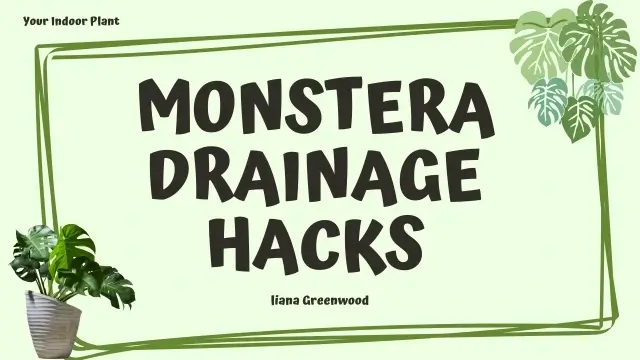Monstera Drainage Hacks: 8 Expert Tips for Better Soil and Root Health

If your Monstera struggles with soggy soil or poor drainage, it’s time for a root-friendly upgrade. The key? Smart drainage hacks that actually work — from soil tweaks to pot tricks.
Best drainage hack for Monstera? Use a chunky aroid mix with orchid bark, perlite, and lava rock — and always choose a pot with drainage holes. Skip pebbles at the bottom!
1. What Good Drainage Looks Like for a Monstera
Monstera roots need both moisture and oxygen. Good drainage means your soil holds enough water to hydrate your plant, but dries out within 4–5 days max. If your soil stays soggy for longer, roots can suffocate or rot.
Signs of poor drainage:
- Yellowing or mushy stems despite dry leaves
- Soil feels wet for a week or more
- Foul smell from the pot
If your Monstera is already showing signs of drooping, check this full guide on why Monstera leaves droop and how to fix it
2. DIY Monstera Soil Mixes That Drain Like a Dream
You don’t need fancy soil bags. Try one of these proven mixes:
Classic Aroid Mix:
- 40% potting soil
- 30% orchid bark
- 20% perlite
- 10% horticultural charcoal
Extra Airy Mix (great for humid climates):
- 50% coco coir
- 30% pumice
- 20% pine bark
💡 Pro Tip: Add a pinch of cinnamon to the mix to help prevent root rot naturally.
3. Skip the Pebble Myth – Here’s What to Do Instead
Despite what you might hear, rocks at the bottom of pots don’t improve drainage. Instead, they create a perched water table — meaning water pools above the pebbles and causes root rot.
Better alternatives:
- Use a mesh screen over the drainage hole
- Try fabric grow bags or self-watering pots with overflow holes
4. Best Pots for Monstera Drainage
The type of pot matters more than most people think. Here’s how they compare:
- Terracotta: Naturally porous and helps wick moisture out
- Plastic: Holds water longer — not ideal for heavy waterers
- Ceramic (glazed): Looks great but can trap moisture
Key rule: Always choose pots with proper drainage holes.
5. Drainage Boosters You Can Add to Any Soil
If your current soil holds too much moisture, try mixing in any of these:
- Perlite (lightweight and cheap)
- Pumice (heavier and lasts longer)
- Lava rock (adds airflow and structure)
- Rice husk charcoal (eco-friendly + detox effect)
📌 Avoid fine sand – it compacts easily and reduces drainage.
6. Smart Drainage Tools Most People Don’t Use
Try these underrated tools to level up your Monstera care:
- Moisture meter: Helps you know exactly when to water
- Mesh netting: Covers the pot hole without clogging
- Self-aerating planters: Designed with airflow gaps to prevent soggy spots
7. How to Fix an Already Soggy Monstera Pot
If you suspect root rot or poor drainage, take action:
- Gently remove the plant from the pot
- Inspect and trim black, mushy roots
- Let roots dry for 15–30 minutes
- Repot in a fresh, airy mix with excellent drainage
- Water only when the top 2 inches are dry

8. Drainage Maintenance Tips You Shouldn’t Ignore
- Clean your pot’s drainage holes every few months
- Use a chopstick to gently aerate topsoil every few weeks
- Avoid letting your plant sit in saucer water for long periods
Want to avoid the most common monstera mistakes? Learn from painful experience in our guide: How I Killed My Thriving Monstera: Learn from My 4 Costly Mistakes
Don’t Let Drainage Hold Your Monstera Back
Even the healthiest Monstera won’t thrive in soggy soil. But with a few smart tweaks — like upgrading your mix, picking the right pot, and using moisture meters or mesh — your plant will grow stronger, taller, and leafier than ever.
📍 Want more? Check out these related articles:
FAQs
-
What is the best soil for Monstera drainage?
A chunky aroid mix with orchid bark, perlite, and coco coir provides ideal drainage and root oxygenation.
-
Should I put rocks at the bottom of my Monstera pot?
No. This common myth actually traps water and causes root rot. Stick to well-draining soil instead.
-
How can I tell if my Monstera has poor drainage?
If the soil smells bad, stays wet for more than 5 days, or the leaves start yellowing, it’s likely a drainage issue.
-
Can I improve Monstera drainage without repotting?
Yes. Mix perlite or pumice into the topsoil gently and make sure your pot has working holes.
-
Do self-watering pots work for Monstera?
They can — if they have an overflow and you use the right soil. Always monitor moisture closely.
